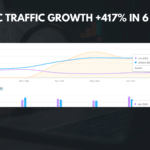
|
Getting your Trinity Audio player ready...
|
Site migrations are a common occurrence in the world of website management. Whether you are moving your site to a new domain, redesigning your website, or restructuring your site’s URL structure, site migrations are necessary to ensure a smooth transition and maintain your site’s SEO rankings.
During a site migration, it is crucial to implement redirects to ensure that visitors and search engines are directed to the new location of your content. This is where the WP 301 Redirects Plugin comes in handy. This plugin allows you to easily create and manage 301 redirects, which are permanent redirects that inform search engines that your content has moved permanently.
The WP 301 Redirects Plugin is a powerful tool that simplifies the process of creating and managing redirects for your WordPress site. With its user-friendly interface and robust features, this plugin is a must-have for anyone undertaking a site migration.
Key Takeaways
- Site migrations require proper redirects to maintain SEO and user experience
- WP 301 Redirects Plugin is a powerful tool for managing redirects
- Installation and setup of the plugin is straightforward
- Redirects can be created for pages, posts, and custom post types
- Broken links and 404 errors can be redirected with the plugin
Understanding the Importance of Redirects in Site Migrations
Redirects play a crucial role in site migrations for several reasons. Firstly, they ensure that visitors who access your old URLs are automatically redirected to the corresponding new URLs. This helps maintain a seamless user experience and prevents visitors from encountering broken links or error pages.
Secondly, redirects are essential for preserving your site’s SEO rankings. When you change the URL structure or move your content to a new domain, search engines need to be informed of the changes so that they can update their indexes accordingly. By implementing redirects, you can ensure that search engines understand the new location of your content and transfer any SEO value from the old URLs to the new ones.
Failure to implement redirects during a site migration can have negative consequences. Visitors who encounter broken links or error pages may become frustrated and leave your site, resulting in a loss of traffic and potential customers. Additionally, search engines may not be able to properly index your new URLs, leading to a decline in organic search visibility and rankings.
Installing and Setting Up the WP 301 Redirects Plugin
Installing the WP 301 Redirects Plugin is a straightforward process. First, log in to your WordPress dashboard and navigate to the “Plugins” section. Click on “Add New” and search for “WP 301 Redirects” in the search bar. Once you find the plugin, click on “Install Now” and then activate it.
After activating the plugin, you can access its settings by navigating to “Settings” and selecting “WP 301 Redirects.” In the plugin’s settings, you can configure various options such as enabling or disabling logging, setting up email notifications for redirect errors, and choosing whether to redirect attachments.
One important setting to note is the “Redirect Method” option. By default, the plugin uses a 301 redirect, which is the recommended method for permanent redirects. However, you can also choose to use a 302 redirect if you want to indicate that the move is temporary.
Creating Redirects for Pages, Posts, and Custom Post Types
| Metrics | Description |
|---|---|
| Number of Redirects | The total number of redirects created for pages, posts, and custom post types. |
| Redirect Type | The type of redirect used, such as 301 or 302. |
| Source URL | The original URL that is being redirected. |
| Target URL | The new URL that the original URL is being redirected to. |
| Redirect Status | The status of the redirect, such as success or failure. |
| Reason for Redirect | The reason why the redirect was created, such as a page or post being deleted or moved. |
Creating redirects with the WP 301 Redirects Plugin is a simple process. To create a redirect for a page or post, navigate to the “Redirects” section in the plugin’s settings. Here, you can enter the old URL in the “Source URL” field and the new URL in the “Target URL” field. Click on “Add Redirect” to save your changes.
If you have custom post types on your site, you can also create redirects for them using the same process. Simply enter the old URL of the custom post type in the “Source URL” field and the new URL in the “Target URL” field.
When creating redirects, it is important to consider best practices for effective redirects. Firstly, make sure that your redirects are one-to-one, meaning that each old URL should have a corresponding new URL. This ensures that visitors are directed to the most relevant content and prevents them from encountering irrelevant or unrelated pages.
Additionally, it is important to use 301 redirects instead of 302 redirects whenever possible. 301 redirects are permanent redirects that inform search engines that the move is permanent, while 302 redirects indicate that the move is temporary. Using 301 redirects helps preserve your site’s SEO rankings and ensures that search engines understand the new location of your content.
Redirecting Old URLs to New URLs with the WP 301 Redirects Plugin
Redirecting old URLs to new URLs is a crucial step in site migrations. With the WP 301 Redirects Plugin, this process becomes quick and easy.
To redirect old URLs to new URLs, simply enter the old URL in the “Source URL” field and the new URL in the “Target URL” field in the plugin’s settings. Click on “Add Redirect” to save your changes.
It is important to ensure that all old URLs are redirected properly to prevent visitors from encountering broken links or error pages. To do this, you can use tools such as Google Search Console or third-party SEO tools to identify any old URLs that are still receiving traffic or have backlinks pointing to them. Once you have identified these URLs, create redirects for them using the WP 301 Redirects Plugin.
Redirecting Broken Links and 404 Errors with the WP 301 Redirects Plugin

Redirecting broken links and 404 errors is another important aspect of site migrations. Broken links occur when a visitor clicks on a link that leads to a page or resource that no longer exists. This can happen during a site migration if old URLs are not redirected properly.
To redirect broken links and 404 errors with the WP 301 Redirects Plugin, you can use its logging feature. When logging is enabled in the plugin’s settings, it keeps track of all requests for non-existent pages on your site. You can then review the log and create redirects for these broken links.
To identify and fix broken links, you can also use tools such as Google Search Console or third-party SEO tools. These tools provide reports on any crawl errors or broken links on your site, allowing you to identify and fix them.
When creating redirects for broken links, it is important to redirect them to the most relevant new URL. This ensures that visitors are directed to the most relevant content and prevents them from encountering irrelevant or unrelated pages.
Managing Redirects and Monitoring Site Traffic with the WP 301 Redirects Plugin
Managing redirects and monitoring site traffic is an important part of maintaining a healthy website. The WP 301 Redirects Plugin provides several features that help you manage redirects and monitor site traffic effectively.
In the plugin’s settings, you can view a list of all the redirects you have created. This allows you to easily manage and edit your redirects as needed. You can also export your redirects to a CSV file for backup purposes or to transfer them to another site.
The plugin also provides a logging feature that keeps track of all requests for non-existent pages on your site. This allows you to identify any broken links or 404 errors and create redirects for them.
To monitor site traffic, you can use tools such as Google Analytics or third-party SEO tools. These tools provide valuable insights into your site’s performance, including metrics such as traffic sources, page views, bounce rate, and more. By monitoring these metrics, you can identify areas for improvement and optimize your site’s performance.
Troubleshooting Common Issues with Site Migrations and Redirects
During site migrations and redirects, it is common to encounter issues that may affect the functionality of your website. Here are some common issues that may arise and tips for troubleshooting and resolving them:
- Redirect loops: Redirect loops occur when two URLs redirect to each other in a continuous loop. This can happen if you have created redirects incorrectly or if there is a misconfiguration in your server settings. To resolve redirect loops, review your redirects and ensure that they are set up correctly. You can also check your server settings and make any necessary adjustments.
- Incorrect redirects: Sometimes, redirects may not work as expected, leading to visitors being directed to the wrong page or encountering error pages. To troubleshoot incorrect redirects, review your redirects and ensure that the source and target URLs are correct. You can also use tools such as the Redirect Checker to test your redirects and identify any issues.
- Broken links: Broken links occur when a visitor clicks on a link that leads to a page or resource that no longer exists. This can happen during site migrations if old URLs are not redirected properly. To troubleshoot broken links, use tools such as Google Search Console or third-party SEO tools to identify any broken links on your site. Create redirects for these broken links using the WP 301 Redirects Plugin.
Advanced Techniques for Site Migrations and Redirects with the WP 301 Redirects Plugin
The WP 301 Redirects Plugin offers several advanced techniques for site migrations and redirects. Here are some techniques you can implement to enhance the effectiveness of your site migrations:
- Wildcard redirects: Wildcard redirects allow you to redirect multiple URLs with similar patterns using a single redirect rule. For example, you can redirect all URLs that start with “/blog/” to a new URL structure by using a wildcard redirect. This technique saves time and effort when dealing with large-scale site migrations.
-
Regular expression redirects: Regular expression redirects allow you to create complex redirect rules based on patterns or conditions. For example, you can create a regular expression redirect to redirect all URLs that contain a specific keyword to a new URL structure. This technique provides more flexibility and control over your redirects.
-
Conditional redirects: Conditional redirects allow you to create redirects based on specific conditions or criteria. For example, you can create a conditional redirect to redirect visitors from a specific geographic location to a localized version of your site. This technique helps provide a personalized user experience and improve conversion rates.
Conclusion and Best Practices for Mastering Site Migrations with WP 301 Redirects Plugin
In conclusion, site migrations are necessary for maintaining and improving your website. The WP 301 Redirects Plugin is a powerful tool that simplifies the process of creating and managing redirects during site migrations.
To master site migrations with the WP 301 Redirects Plugin, here are some best practices to keep in mind:
- Plan your site migration carefully and create a comprehensive redirect plan before making any changes to your site.
-
Use 301 redirects instead of 302 redirects whenever possible to preserve your site’s SEO rankings.
-
Test your redirects thoroughly to ensure that they are working correctly and directing visitors to the intended pages.
-
Monitor your site traffic and performance regularly using tools such as Google Analytics or third-party SEO tools.
-
Stay up to date with the latest SEO best practices and algorithm updates to ensure that your site remains optimized for search engines.
By following these best practices and leveraging the features of the WP 301 Redirects Plugin, you can successfully navigate site migrations and maintain the integrity of your website.
If you’re interested in learning more about the crucial role of SEO services in Chandigarh‘s digital landscape, you should check out this informative article by Media Officers. It provides valuable insights into how SEO services can greatly impact the online presence and success of businesses in Chandigarh. Additionally, if you want to stay ahead of the game and understand what’s changing in the world of SEO in 2023, Media Officers has also published an ultimate guide that highlights the key trends and why they matter. Lastly, if you’re specifically looking for a pharmaceutical SEO company, Media Officers offers specialized services tailored to the unique needs of the pharmaceutical industry. Don’t miss out on these valuable resources!
FAQs
What is WP 301 Redirects Plugin?
WP 301 Redirects Plugin is a WordPress plugin that helps you manage and redirect your website’s URLs. It allows you to create and manage 301 redirects, which are permanent redirects that help maintain your website’s SEO and user experience.
Why do I need WP 301 Redirects Plugin?
You may need WP 301 Redirects Plugin if you have changed the URL structure of your website, deleted pages, or moved content to a new location. Without proper redirects, visitors may encounter 404 errors, and search engines may penalize your website’s ranking.
How does WP 301 Redirects Plugin work?
WP 301 Redirects Plugin works by creating a redirect from the old URL to the new URL. When a visitor or search engine crawls the old URL, they will be automatically redirected to the new URL, preserving the SEO value and user experience.
Is WP 301 Redirects Plugin easy to use?
Yes, WP 301 Redirects Plugin is easy to use. It has a user-friendly interface that allows you to create and manage redirects with just a few clicks. You don’t need any coding skills or technical knowledge to use this plugin.
Is WP 301 Redirects Plugin free?
WP 301 Redirects Plugin has both free and premium versions. The free version allows you to create and manage redirects, while the premium version offers additional features such as bulk redirects, import/export, and priority support.
Can WP 301 Redirects Plugin help with SEO?
Yes, WP 301 Redirects Plugin can help with SEO. By creating and managing 301 redirects, you can preserve the SEO value of your website’s pages and avoid penalties from search engines. It also helps to maintain a good user experience by redirecting visitors to the correct page.

























































